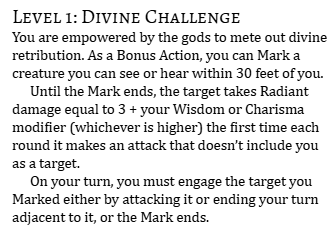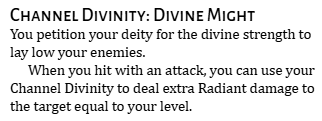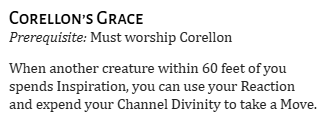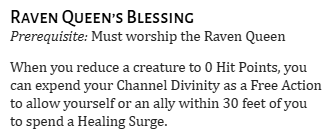Designing 4ever: Stealing from the 4e Paladin
Estimated read time: about 10 minutes
This article's all about the beloved Paladin class and how we're tackling it in Project 4ever! What thematic and mechanical nuggets will we unearth from D&D 4e, and port over to 5e?
Note that we're going to reference some 4e terminology like power sources and combat roles. If you're not sure what those are or could use a refresher, feel free to jump back and glance over those articles!
If you're already familiar with how the 4e Paladin works and aren't interested in a little history lesson, go ahead and jump to the "So What Are We Stealing?" section.
Defenders of Justice
So the Paladin in 4e was introduced right from the first Player's Handbook as the "Divine Defender" class. As you might expect, it shared some functionality with both the other Defender in that book (the Fighter) and the other Divine class (the Cleric).
There’s almost always been some thematic overlap between the Cleric and the Paladin across the editions of D&D, in that they tend to be associated with deities or holy power. And depending on the particular builds, you could often make characters of each class that were fairly similar to each other. But in 4e it was the Paladin that could wear the heaviest armor and mark enemies, while the Cleric had access to better healing and buffs. Paladins could also be built to deal significant damage, which Clerics often had trouble doing on their own.
4e Paladins were notable in that they didn’t necessarily have to have the loftiest moral alignment, such as the Lawful Good requirement of past editions. Instead, their alignment merely had to match their deity’s. This trend led directly to the looser restrictions of Paladins in 5e, where they are encouraged to stay true to their sworn oaths rather than the direct tenets of any deity.
Soldiers of Virtue
And then there’s the comparison to the Fighter. Where the Fighter really focused on defining the battlefield's front line and being extremely 'sticky' and engaging the enemy, the Paladin played slightly more loosely, with part of its attention focused not on the enemies, but on its own allies with some buffs and healing. It was generally less aggressive than the Fighter, though it certainly could bring the fight to the enemies when it wanted to with certain build options.
There were some other key differences between Fighter and Paladin, particularly in regards to defense: the Paladin was the only class in 4e that started play with training in plate armor, and it also boasted the highest number of healing surges. Add in that its suggested ability scores emphasized Charisma, and the Paladin also had an impressive Will Defense, something which was a bit of a weak point for the typical Fighter build.
One last interesting point is that 4e Paladins could be built to rely solely upon Charisma for their weapon attacks. Paladin powers that used Strength tended to deal more damage, but Charisma weapon powers were certainly supported and effective. This is something that became more common in 4e’s design as the edition went along, that characters could more easily use other abilities than Strength for their attacks.
So, What Are We Stealing?
The Paladin is one of the most popular classes of 5e! So what can we bring from 4e to possibly improve the class? No doubt some of these things will be controversial, so feel free to let us know what you think in the comments below.
Level 1: Hit Points & Proficiencies
As the 4ever Paladin is meant to be a Defender, we’re going to keep that d10 Hit Die. Martial weapons are a must. Following 4e’s example, we’re going to have the Paladin start with training in all armor. Gotta have that knight in shining armor, right? This does mean that the Paladin can start with Plate and a Heavy Shield for 20 AC, but not to worry; with how we’ve been designing encounters and monsters, the math holds up.
We’re also going to keep the 5e Paladin’s proficiency in Wisdom saving throws, which in Project 4ever translates to adding your Proficiency Bonus to your WILL Defense and saving throws.
Level 1: Lay on Hands
This first feature feels almost like one befitting a Leader rather than a Defender, but it’s traditionally been a part of the Paladin class since forever, and works to set the Paladin up as a secondary Leader.
Let’s check it out:
Like the Cleric’s Healing Word Feature, Lay on Hands requires a Bonus Bonus action to use—which is pretty handy in the middle of a fight. However, it can’t be used at range and the Paladin can’t use it on itself. Actually, it accomplishes a very Defendery thing in that it lets the Paladin directly sacrifice its own healing pool to allow an ally to regain Hit Points. That’s exactly what Defenders are meant to do, take the damage so that other characters don’t have to.
Level 1: Divine Challenge
Here’s the bread and butter of any Defender class: the ability to Mark enemies. While the 4ever Fighter can Mark a foe just by attacking it, and then enforcing the Mark by making off-turn attacks, the Paladin instead simply Marks a foe with its Bonus Action. It’s fittingly non-violent, actually, like the Paladin is saying, “Don’t hurt my friends, or you’ll regret it.” Then, if the Marked enemy attacks someone other than the Paladin, the enemy just automatically takes some Radiant damage. The damage doesn’t come from the Paladin, it’s almost like a zap of divine energy from on high.
Have a look:
Now, there are sometimes gameplay problems when a Defender can Mark and enforce at range like the Paladin can. You could potentially have the Defender ping an enemy with its Mark, and then run off and leave the enemy to face the rest of the characters with a permanent Hitch to its attack rolls. Needless to say, that’s not very Paladin-like behavior. So Divine Challenge comes with a caveat: the Paladin needs to be actively engaging the Marked enemy, or the Mark ends. As mentioned in the feature’s description, that means the Paladin needs to either attack that Marked enemy, or else be in the enemy’s face by placing itself adjacent.
Level 1: Code of Virtue
This feature has taken a lot of thought and iterations, so we could really use some feedback on it. Mechanically, it’s meant to give some options at level 1 and enable a few different playstyles. Narratively, it’s become a way for each Paladin to lay out its own unique code of behavior.
So your code is made up of three “tenets”, which are little snippets of morality that each have a mechanical benefit attached. You choose the tenets from a list of about ten options. Here are a few examples:
Note that we’ve made it possible to build your Paladin to use Wisdom or Charisma for your weapon attacks. So often Paladins are spread thin across the many abilities they need to be effective, and it can be a real headache. This should help with that if you’re feeling a bit stuck in how to allot your ability scores.
In one of our past iterations we had this idea that you would “focus” or “meditate” on one tenet at a time and gain its benefits, but then in battle could speak the words of another tenet to switch over to its benefits and get a little powerup as you go. A bit reminiscent of Brandon Sanderson’s Knights Radiant, perhaps. That idea ended up being a bit complicated in implementation, so we simplified it to what we have now.
Be sure to let us know what you think!
Level 2: Channel Divinity
We’ve been working on ways to connect the classes of each power source, and with Divine classes one of the ways we’ve accomplished this is through the Channel Divinity feature. Functionally it’s a bit like its own baby spellcasting feature, but you can kind of invest as much or as little of your character as you want in it.
So how it works is you get one use of your “Channel Divinity”, which comes back on a Short Rest, and you can use it to power some special effects. For example, any Cleric can use Turn Undead to deal some good damage to zombies and skeletons and such, and they also get one other option through their choice of Domain. All Paladins, on the other hand, get the Divine Mettle and Divine Might options.
I mentioned that you can invest as much or as little into this feature as you want. Well, that comes into play through the Talent system. There are a number of “Channel Divinity” talents that you can opt into that improve the feature, either by directly increasing its effectiveness or by giving additional options for it. Here are a few talents that are each based on a particular deity:
These Channel Divinity talents are open to anyone who has the Channel Divinity feature, which is basically all Divine classes. So you could potentially have a Cleric and a Paladin that have access to the same Channel Divinity options.
Level 2: Spellcasting
And here’s the true Spellcasting feature for Paladins. This is the first half-caster (or “Adept”) class that we’re introducing for playtesting, and so its spellcasting progression is considerably slower than, say, the Wizard’s, but still forms an important part of the class.
Right away, I knew I wanted to let the Paladin be able to use Wisdom as its spellcasting ability, instead of being locked into Charisma. No doubt Charisma is a classic way to represent the knight in shining armor, but I also have a love for Paladins of a more reserved nature, and I feel that Wisdom represents that fairly well.
You might have noticed that it’s possible to have your Paladin dump Strength entirely and focus exclusively on either Wisdom or Charisma for both your weapon attacks and your spells. That’s by design. Though, be aware that if your Strength score is too low you won’t be able to make use of some of the best armor in the game, so watch out for that.
The spells themselves are directly inspired by the 4e powers. So there are many spells that involve melee weapon attacks, and a few choice spells that do ranged spell attacks. Thrown into the mix are a fair amount of buff spells for yourself or an ally or even the entire party, highlighting your secondary role as a Leader.
Level 3: Paladin Subclass
We were faced with the decision here to draw our inspiration from 5e’s subclasses based on very flavorful Sacred Oaths, or instead pull more deeply from 4e with its Paragon Paths for Paladins. We actually ended up going both ways to some extent.
Here’s what we have:
Order of Devotion: The classic Paladin concept, similar to 5e’s Oath of Devotion in theme, but with some fresh mechanics focused on being a Defender.
Order of the Ancients: Despite the familiar name, this one combines some of Unraveled Archives past work on an “Oath of Wonder” subclass with a love of the Feywild. It’s not so much 5e’s “nature” Paladin as it is a bright and magical fey knight.
Order of the Gray Guard: We could have named this one “Order of Vengeance”, but that would step on the toes of a little-known class unique to 4e that we plan to introduce in the future. Instead, we drew on a 4e Paragon Path for Paladins and to make a sort of morally gray inquisitor.
We have loads of other ideas for Paladin subclasses, but these are the three we’ve decided to introduce for playtesting. Please let us know what you think!
Level 4: Divine Inspiration
We’ve seen this before with the Cleric, so I won’t dive into it too much. Basically, when you spend your Inspiration, you also can pick yourself or an ally to spend a Healing Surge and get some Hit Points back. This bit of free healing has definitely come in handy in playtests!
Level 5: Weapon Prowess
If you’ve kept up with these articles, Weapon Prowess shouldn’t be anything new to you. It’s just an extra weapon die of damage whenever you hit with a weapon attack. Many classes that make use of weapons have access to it at level 5.
Thing is, most classes also get some sort of a powerful “daily” ability at level 5, like the Exploits of Martial classes or a Wizard’s level 3 Fireball spell. A class like the Paladin that is built on the Adept chassis unlocks its level 2 spells at this level, which function as its “daily” feature.
Wrapping it Up
And that’s the first 5 levels of Project 4ever’s Paladin! Hopefully it gives some idea of what we intended with our design choices. If any thoughts occurred to you while reading or skimming through this article, we’d really love to hear them. Feel free to drop a comment in the section below, or join our Discord server to engage with us more directly. We’d love to meet you! You may even be able to join us in some playtests, if you’re so inclined.
But until all of that, happy gaming, and we’ll see you in the Archives!















